The Thick Hijab: A Blend of Fashion and Cultural Identity
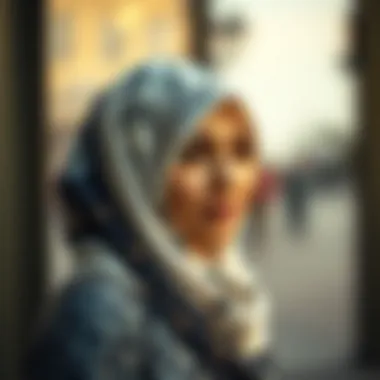
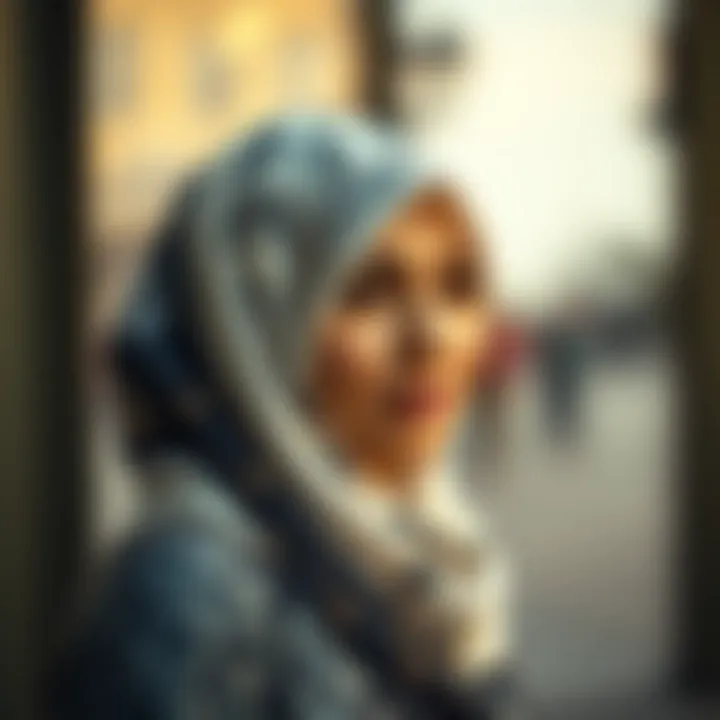
Intro
The thick hijab has become a pivotal piece within the tapestry of fashion and cultural identity. It’s not just a piece of fabric that covers; it encapsulates beliefs, history, and a sense of community. Though it may often be seen solely as a modest garment, its significance runs far deeper. This article dives into the multifaceted aspects of thick hijabs—examining their evolution, contemporary trends, and how they serve as vessels of personal and collective expression.
Fashion Trends
Emerging Styles
In the fast-paced world of fashion, thick hijabs are emerging as vibrant contenders on the runway. Designers are reimagining traditional styles to cater to modern sensibilities while ensuring cultural integrity. From bold patterns to unique textures, the thick hijab is seeing a transformation that keeps it relevant in both casual wear and high fashion.
Seasonal palettes are particularly influential. For instance, during the fall, deep hues such as burgundy and navy blue dominate, paired with textured fabrics like wool or heavier cotton to maintain warmth. In contrast, spring may usher in lighter shades and breathable materials, allowing for versatile styling options. Wearing a thick hijab doesn't mean sacrificing style; it presents an opportunity to make a statement, drawing inspiration from both traditional practices and contemporary norms.
When looking to incorporate these styles into one’s wardrobe, aesthetics remain key. Layering options, such as long cardigans over fitted tops, can seamlessly coexist with a thick hijab, creating an elegant silhouette. Exploring the use of accessories, like statement earrings or layered necklaces, can further enhance the overall look. These elements combined bring together not just fashion, but significant cultural narratives.
Seasonal Must-Haves
Each season ushers in a wave of trends that can be adapted to thick hijab wearers. Here are some essentials to consider:
- Soft Knit Scarves: Perfect for chilly weather, they offer both style and comfort.
- Flowy Maxi Dresses: In warmer months, these can be paired with a thick hijab for an effortlessly chic look.
- Layered Jackets: These complement the hijab's thick fabric without overshadowing it, ideal for transitional weather.
- Comfort-Driven Fabrics: Materials such as jersey or bamboo provide breathability alongside coverage.
The careful selection of seasonal items helps keep an individual's fashion game sharp and culturally attuned.
Timeless Fashion
Classic Pieces
The thick hijab is often accompanied by classic pieces that withstand the test of time. Consider the everlasting appeal of a black blazer or the charm of a crisp white shirt. These staples can easily be paired with a hijab, presenting a polished and sophisticated look suitable for various occasions.
Additionally, items like tailored trousers or A-line skirts are versatile and can enhance the overall appearance without crowding the hijab's prominent role. It’s essential to curate a wardrobe filled with these timeless pieces as they provide a strong foundation from which one can experiment with seasonal trends.
Styling Tips
To breathe new life into classic styles, consider these practical tips:
- Mixing Textures: Pair a smooth hijab with a chunky knit sweater for balanced visual interest.
- Playing with Proportions: A longer hijab can complement a cropped top, creating an engaging silhouette.
- Accessorizing Wisely: When wearing heavy fabrics, keep jewelry understated. Instead, let the hijab shine as the focal point.
- Color Coordination: Maintaining a cohesive color story—using complementary shades—can tie together any outfit neatly.
In essence, the thick hijab is not merely an accessory but a significant aspect of personal expression that speaks volumes. Its implications stretch beyond fashion into cultural realms, affirming identity and fostering connections among diverse communities. Whether it’s embraced as a fashion statement or a sacred tradition, the thick hijab retains its standing as a powerful symbol in today’s world.
The thick hijab symbolizes not just personal style, but a rich narrative of cultural heritage and modern identity.
For further insights on fashion and cultural intersections, consider exploring resources from Wikipedia, Britannica, and relevant fashion blogs on Reddit.
Prelude to the Thick Hijab
The thick hijab stands at the confluence of tradition and modernity, weaving its way through the intricate fabric of both fashion and cultural identity. As we delve into this exploration, it becomes essential to underscore its importance. There’s a complexity in wearing a hijab that extends beyond mere fabric; it encapsulates a spectrum of beliefs, customs, and individual expression. In many cultures, the hijab is not just a piece of clothing. It is a statement of modesty, yet it can also serve as a canvas for personal style. Consequently, understanding the thick hijab allows us to engage with its historical and contemporary significance.
Defining Thick Hijabs
When discussing thick hijabs, we are inclined to define them not just by their material thickness, but by the intention behind their use. Thick hijabs can be made from a variety of fabrics, including jersey, cotton blends, and even wool, offering warmth and structure.
Thick hijabs often provide more coverage, which can be particularly appealing in various climates or cultural settings. The materials used contribute to both the look and functionality, each bringing its nuances. For example, jersey hijabs are favored for their stretch and comfort, making them ideal for casual wear, whereas a thick wool option could be perfect for colder weather, combining style with practicality.
From a fashion perspective, thick hijabs also allow for a myriad of styles and creative ways to incorporate accessories. They can be layered, tied in intricate knots, or paired with various outfits, showcasing versatility that some may not often consider. This adaptability speaks volumes about the connection between one’s cultural identity and individual expression.
Historical Evolution
The journey of the thick hijab through history is as rich as the cultures it represents. Historical records indicate that head coverings have been used for thousands of years across various civilizations. From the elaborate wraps of queens in ancient Egypt to the simpler designs often seen in today’s various cultures, the hijab has undergone significant transformations.
In the 20th century, the thick hijab began to emerge more prominently in the West as a response to broader social changes. Through the lens of feminism and personal autonomy, many Muslim women started to re-embrace the hijab as a choice rather than an imposition. This shift emphasized that wearing a thick hijab can signify an empowered identity, pushing back against stereotypes that often label it solely as a symbol of oppression.
During the 21st century, with the rise of social media, influential figures and fashion icons have propelled thick hijabs into mainstream discussions of style and identity, redefining how they are perceived. This has opened doors for many women, inviting them to wear their identity with pride while setting fashion trends that challenge conventions.
In summary, defining and understanding the thick hijab not only enhances our comprehension of its essence but also acknowledges the rich history and cultural evolution that have shaped its current presence in fashion. The thick hijab is not merely a practical garment; it's a powerful statement that embodies the complexity of cultural heritage and modern fashion dynamics.
Cultural Significance of the Thick Hijab
Understanding the cultural significance of thick hijabs requires a nuanced look at how they function within various societies. It is often not just about modesty; it intertwines with identity, pride, and resistance against prevailing trends. In times when fashion and culture are in constant flux, the thick hijab emerges as a symbol of steadfastness, deeply rooted in tradition while adapting to modern interpretations.
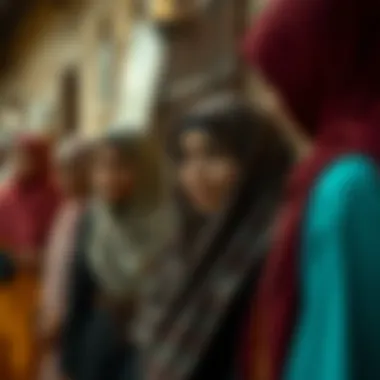
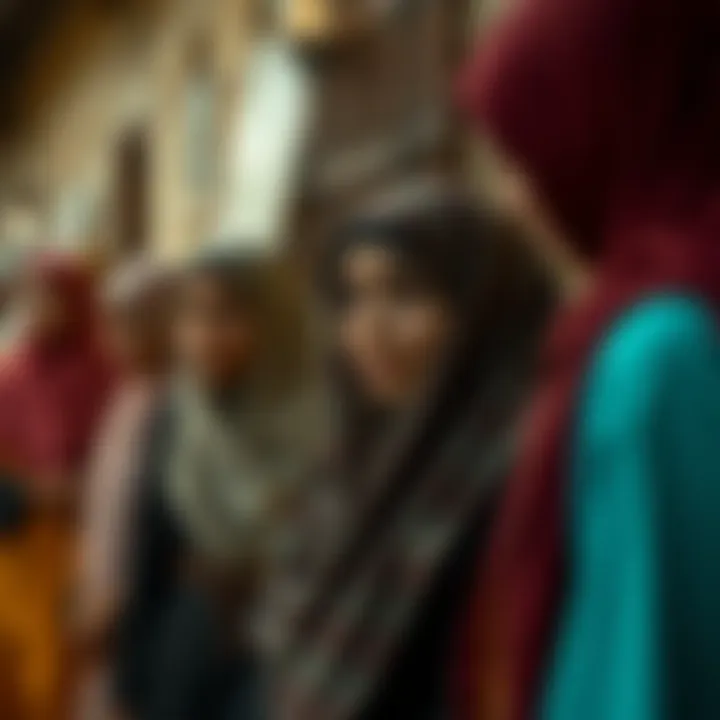
Thickness and Modesty
The thick hijab is a powerful manifestation of modesty in many cultures, particularly within Islamic traditions. The thickness of the fabric contributes to a sense of protection both physically and psychologically. It's said that “what’s on the outside often mirrors what’s on the inside”, and for many women, wearing a thick hijab translates to a comfortable space where they can express their faith. The choice of a thicker fabric can often be linked to the climate and regional customs, adding another layer to its significance.
Different cultures exhibit distinct interpretations of modesty. For instance, in some communities, a thick hijab signifies purity and an adherence to modest dress codes commanded by religious beliefs. Conversely, others may view it as a fashion statement or a personal choice reflecting one's individuality. This dual representation showcases the rich tapestry of how the thick hijab can vary in meaning based on context.
Ultimately, the decision to wear a thick hijab often embodies a woman’s agency. It reflects personal choices shaped by cultural norms rather than a mere conforming to them. As such, the thickness of the hijab becomes not only a means of modesty but a vessel of empowerment. Women can reclaim their narratives in various environments, proving that modesty can harmonize with creativity and flair.
Symbolism in Different Cultures
From Morocco’s vibrant colored thick hijabs adorning bustling souks to the intricate embroidery seen in South Asian styles, the symbolism of thick hijabs weaves through cultures like threads of a rich tapestry. Each stitch and fold often reflects more than just practicality; they embody history and communal values.
- In Middle Eastern cultures, thick hijabs are adorned with patterns and motifs that signify one's heritage, age, and even marital status. For instance, a newly married woman might adorn herself with a hijab that reflects her transition into womanhood.
- In Southeast Asian cultures, the thick hijab's colors often express personality. Bright hues are preferred by the youth while more subdued tones may dominate the styles of older generations. This cultural conversation ensures the thick hijab adapts while maintaining its essence.
- Additionally, some communities use the thick hijab as a form of resistance against Western fashion norms, asserting their cultural identity with pride. By donning the thick hijab, they are making a statement that their identity is non-negotiable.
The symbolism that thick hijabs carry speaks volumes about personal beliefs and collective identities. Rather than being mere fashion choices, these garments tell stories of dynasties, family legacies, and individual resolve. Each woman who wears one carries a multifaceted narrative, adding depth and diversity to the evolving dialogue on culture and fashion.
The thick hijab is more than fabric; it's a canvas that displays a spectrum of identities, firmly framing the individual's beliefs and cultural backgrounds.
Materials Used in Thick Hijabs
The materials used in thick hijabs are essential components that shape not just their aesthetic appeal but also their functionality. As the world of fashion evolves, understanding the fabric's significance is key to appreciating how these garments meet both cultural and practical demands. Thick hijabs serve multi-faceted purposes; they are both a symbol of identity and an expression of personal style. Selecting the right material can affect comfort, styling, and even the durability of the hijab.
Fabric Options and Their Attributes
When it comes to the fabrics utilized in crafting thick hijabs, there's a palette of options available, each with its unique attributes:
- Cotton: Known for its breathability and softness, cotton is a popular choice. It's lightweight yet offers sufficient coverage, making it ideal for warmer climates. However, it's crucial to choose varieties like organic cotton for added sustainability.
- Polyester: This synthetic fabric is often blended with other materials to enhance durability and wrinkle resistance. However, it tends to trap heat, which might not be suitable for all environments, especially in summer heat.
- Silk: Considered luxurious, silk thick hijabs can drape beautifully. They convey elegance but require delicate care and might not suit every casual wear setting. The smooth texture often makes them a favorite for formal occasions.
- Viscose: This semi-synthetic material is revered for its similar properties to silk but at a more accessible price. It manages to feel soft against the skin while retaining a good structure.
Selecting the right fabric therefore requires consideration of not just personal preference but also the context in which the hijab will be worn.
Breathability vs. Coverage
In the world of thick hijabs, a constant tension exists between breathability and coverage. How do you choose? This will largely depend on personal needs, seasonal factors, and cultural expectations.
- Breathability: Fabrics that allow air circulation are paramount in warmer climates, as they prevent discomfort. High-quality cotton and viscose are often favored for their ability to keep the wearer cool.
- Coverage: On the flip side, thicker fabrics often provide better coverage, an aspect that holds significant cultural weight for many wearers. When opting for coverage, the weight and thickness of the fabric must be factored in, as heavier materials might inhibit breathability, especially in humid conditions.
It’s not merely about the aesthetics of the hijab; the material plays a pivotal role in ensuring comfort and respect for cultural values. Finding a balance between these competing needs is where many women find empowerment in their daily choices regarding hijab wear.
"Choosing the right fabric for a thick hijab extends beyond personal taste; it becomes a vital part of one’s cultural and personal expression."
Thus, the exploration of materials used in thick hijabs not only enhances their visual appeal but becomes interwoven with the identities and experiences of those who wear them. Recognizing and understanding these facets can lead to a more informed and enriching approach to fashion and cultural expression.
Fashion Trends Involving Thick Hijabs
When it comes to thick hijabs, the fusion of fashion and cultural identity creates a vibrant spectrum of trends that resonate beyond mere aesthetics. Thick hijabs have evolved from a simple garment into a powerful statement piece reflecting individual style, personal beliefs, and modern trends. In this section, we will dissect the nuances of fashion trends involving thick hijabs, with a keen eye on contemporary influences and the key players shaping this sector.
Contemporary Style Influences
The modern hijabista navigates through a world of diverse aesthetics, seamlessly blending traditional elements with contemporary flair. The thick hijab stands front and center in this transformation, embodying both practicality and style. Designers are taking cues from street style, high fashion, and even social media trends, leading to a rich tapestry of styles.
In today's landscape, thick hijabs are no longer confined to the classic, monochromatic styles often seen in the past. Instead, vibrant colors, intricate patterns, and unique layering techniques dominate the scene.
- Layering and Textures: One prominent trend is layering; thick hijabs are often paired with light fabrics, allowing for a dynamic interplay of textures. This not only adds depth but allows wearers to express individuality.
- Bold Colors and Patterns: From striking floral prints to geometric designs, the choice of color and pattern has become a vital aspect of modern hijab fashion. Bright hues can energize an outfit, while subtle tones may exude elegance.
- Athleisure Influence: Inspired by the athleisure boom, many opt for more casual, sporty looks by pairing thick hijabs with jackets and joggers. This practicality strikes the perfect balance between comfort and style.
Ultimately, contemporary style influences pave the way for an expansion of choices, shifting the narrative around thick hijabs from modesty alone to an emblem of personal empowerment.
Notable Designers and Brands
The thick hijab has attracted attention from a diverse array of designers and brands, each contributing to its growing prominence in fashion. This meld of creativity and culture has birthed lines that showcase the beauty of thick hijabs while remaining respectful of their significance.
- Nusret Kamali: This Turkish designer engages in combining modern cuts with traditional fabric types. Nusret’s collections often showcase thick hijabs draped artistically, showcasing the wearer’s face while maintaining modesty, emphasizing elegance and grace.
- Aab: A British brand that offers a blend of contemporary and traditional elements. They focus on inclusive fashion, creating thick hijabs that cater to various body types while embracing cultural roots.
- Zara: As a mainstream powerhouse, Zara’s occasional collections featuring thick hijabs indicate the increasing acceptance and integration of hijabs in global fashion scenes. Their designs, while commercial, are becoming more thoughtful, pushing boundaries in popular culture.
- H&M: Another global giant, H&M has started to incorporate thick hijabs into their lines, showcasing a commitment to diversity. They have embraced bold colors and patterns, appealing to a younger demographic eager to express their identities.
"Fashion is not just about clothes, it’s about a statement of who we are and what we believe."
Through these designers, the thick hijab evolves from a garment of necessity into one of choice, enabling wearers to embody their identity in a way that resonates with modern sensibilities. Each collection adds layers of meaning to the thick hijab, reinforcing its place in the tapestry of contemporary fashion.
As the landscape of thick hijabs continues to change, both trends and designers steward this transformation, highlighting the beauty and relevance of these garments in today's society.
Epilogue
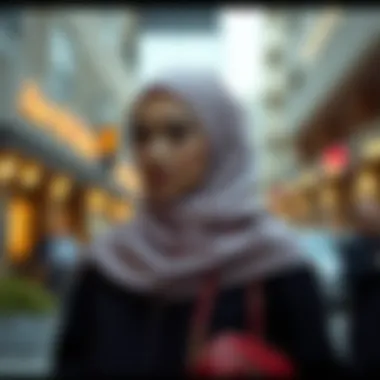
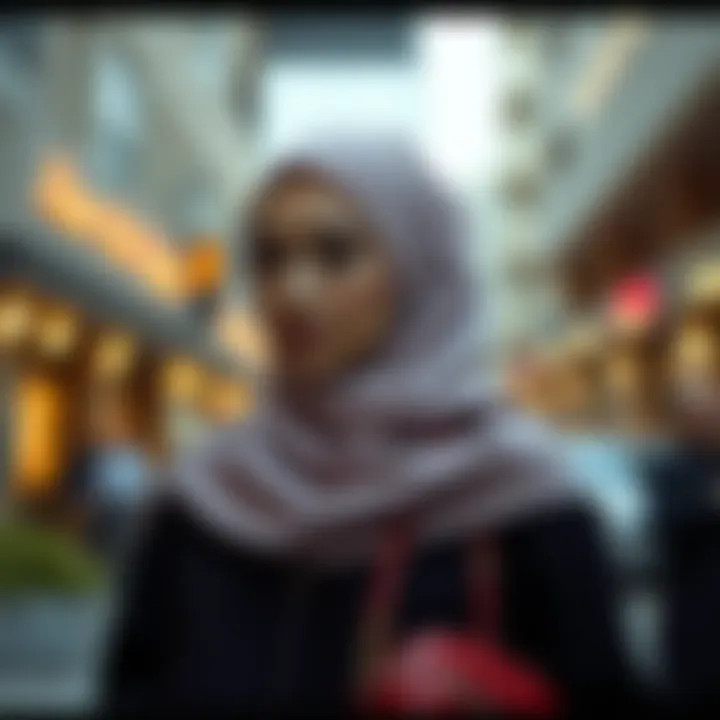
In this fast-paced world, the thick hijab stands resilient, intertwining tradition and modern influences. As fashion continues to evolve, its presence reminds us that style can be an authentic expression of heritage, belief, and individuality.
Thick Hijabs in Everyday Wear
Thick hijabs hold an important place in everyday wear, providing not just coverage but also allowing for a distinct style statement that resonates deeply with personal and cultural identity. In today’s fast-paced world, the thick hijab serves as a canvas for self-expression, merging tradition with contemporary fashion sensibilities.
Unlike thinner fabrics, thick hijabs offer a different level of warmth, comfort, and modesty. They can be styled in numerous ways to suit many occasions—from casual meet-ups to formal events, making them a versatile wardrobe staple. Beyond their practical aspects, thick hijabs can elevate an outfit, offering both a shield of modesty and a flair of elegance.
Styling Tips for Various Occasions
When it comes to styling thick hijabs, there are countless creative avenues one can explore. Here are several practical tips to suit various occasions:
- Casual Outings: Opt for lightweight cotton or jersey materials that are breathable yet provide ample coverage. Pair these hijabs with a simple turtleneck and jeans for a fresh look.
- Professional Settings: A thicker, structured fabric like a wool blend can bring a polished touch. Choosing solid colors or subtle patterns works wonders when layered under a blazer.
- Formal Events: For special occasions, consider luxurious materials such as silk or satin. They drape beautifully and can be accentuated with decorative pins or brooches for an added touch of sophistication.
- Cultural Celebrations: During cultural festivities, embrace rich colors and intricate designs. A patterned hijab can be the centerpiece of your attire, reflecting heritage while still being trendy.
Each of these suggestions allows the wearer to not only adhere to their personal or cultural standards but also feel confident and stylish.
Seasonal Styling Considerations
Seasonal variations bring fresh opportunities for styling thick hijabs. Understanding the climate can significantly influence both comfort and style choices:
- Summer: Look for thick hijabs crafted from lightweight yet opaque materials to ensure breathability while maintaining modesty. Lighter colors can reflect sunlight and keep you cool. Consider pairing the hijab with sleeveless tops and maxi skirts for a breezy summer aesthetic.
- Autumn: This season often calls for layers. Opt for thick hijabs made from soft, warm fabrics, perfect for pairing with cozy sweaters or trench coats. Earthy tones can resonate with the season, providing warmth both literally and stylistically.
- Winter: Heavy, insulated fabrics can provide warmth against the cold. Combine thicker hijabs with woolen outerwear for a well-coordinated winter look. Darker, richer colors are popular during winter, making garments feel rich and luxurious.
- Spring: Light and airy materials that still possess warmth for brisk days are ideal. Floral patterns can accentuate the renewal of nature, while pairing them with lighter layers allows for a brighter, more refreshed ensemble.
Embracing the seasonal considerations not only enhances personal style but also ensures that the thick hijab remains functional across varying weather conditions. This tailored approach invites individuals to express themselves uniquely, reflecting personal style while embracing the thick hijab’s cultural significance.
Personal Expression Through Thick Hijabs
In an age where increasing individuality is celebrated, the thick hijab has transcended its traditional role, becoming a canvas for personal expression. Especially in the realm of fashion, this piece of clothing symbolizes much more than modesty; it encapsulates identity, creativity, and personal style. As women experiment with their thick hijabs, they explore cultural narratives while asserting their unique flair.
Individual Styling Choices
The beauty of the thick hijab lies in its versatility. Women around the world adorn their hijabs in countless ways, from draping styles to color palettes, fabrics, and accessories. Take Zara, who prefers a deep burgundy thick hijab with intricate embroidery that pays homage to her heritage. Her choice reflects not only her dedication to her culture but also her flair for artistry. The thick hijab can be paired with bold jewelry or understated casual wear, transforming its role from a simple head covering to a statement piece that resonates with personal identity.
Personal styling choices are crucial, as they represent a woman’s approach to femininity and spirituality. Rania opts for a monochromatic look, combining shades that blend seamlessly with her outfits, while Amanda experiments with prints and textures that reflect her dynamic personality. These choices are not merely aesthetic; they're personal declarations, asserting one's values and beliefs while navigating societal expectations.
"Fashion should be about expressing yourself, and a thick hijab can be just as much a part of that as any other garment."
DIY and Customization Trends
In recent years, the trend of do-it-yourself (DIY) and customization has surged, particularly among those who wear thick hijabs. This phenomenon allows wearers to put their unique stamp on their accessories, creating a look that resonates personally and culturally. Social media platforms, especially Pinterest and Instagram, are replete with tutorials that encourage women to personalize their thick hijabs. Whether it’s adding embellishments, dyeing in unique colors, or even designing their own patterns, women are reclaiming agency over their wardrobe choices.
Customization goes beyond aesthetic appeal; it also doubles as a celebration of culture. For instance, some women use local fabrics that reflect their indigenous traditions, while others engage in ethical practices, upcycling materials that carry a story. The DIY approach fosters a community of like-minded individuals who share tips, empowering them to express their identities while promoting sustainability.
With these trends gaining traction, many hijab brands have begun offering customizable thick hijabs, allowing customers to choose fabrics, colors, and styles, further encouraging personal expression. This confluence of tradition and innovation beautifully embodies the multifaceted nature of thick hijabs in today’s fashion landscape.
Social Perceptions of Thick Hijabs
The thick hijab is often seen through a multifaceted lens, reflecting not only fashion aesthetics but also deep cultural narratives. Understanding the social perceptions surrounding thick hijabs is vital in unpacking their significance in today's global society. This section will explore the various dimensions of how thick hijabs are perceived, the media’s role in shaping these views, and the broader conversations about identity they evoke.
Media Representation and Misconceptions
In the age of social media and instant news, the representation of thick hijabs in media plays a crucial role in shaping public perceptions. Unfortunately, misrepresentation remains rampant. Images of thick hijabs are often accompanied by stereotypes, casting wearers as oppressed or overly traditional. Such portrayals paint a narrow picture, overlooking the diversity and richness of those who choose to wear them.
For instance, a study I read mentioned that while some media outlets emphasize a homogenous view of hijab wearers, each individual carries their unique story, style, and purpose behind wearing a hijab. The thicker fabric, favored for its modesty and traditional connotations, can often be a springboard for self-expression rather than a symbol of restriction.
"When the stories we tell are simplified, we miss the beautiful tapestry of cultures that thick hijabs represent."
Luckily, there are emerging voices in fashion and culture that challenge these misconceptions. Influencers and designers highlight thick hijabs in diverse fashion settings, breaking past the rigid stereotypes. This shift is vital for offering a more nuanced portrayal in the media, encouraging people to look beyond surface appearances. As they say, there are always two sides to every story, especially in the context of cultural attire.
Conversations on Identity
The thick hijab is more than just a piece of clothing; it’s a canvas upon which women paint their identity. For many, wearing the hijab, especially a thick one, can signify a conscious choice — an assertion of individuality in the face of societal pressures. These conversations about identity are burgeoning, providing a rich terrain for understanding how culture and personal beliefs intertwine.
Among the key elements in these discussions is the notion of reclaiming identity. Sometimes, the choice to wear a thick hijab can be an act of defiance against cultural stereotypes, rejecting the notion of the oppressed Muslim woman. Instead, it’s about empowerment; this fabric becomes a statement of strength and pride.
To add to this discourse, diverse dialogues are unfolding in social circles and academic settings. People are beginning to appreciate that each hijab does not have to conform to a specific narrative, allowing wearers to infuse their personality into the styles they choose.
In essence, conversations surrounding thick hijabs are not just about clothing; they reveal broader themes of self-acceptance, cultural pride, and the quest for authentic self-expression in a world filled with misconceptions.
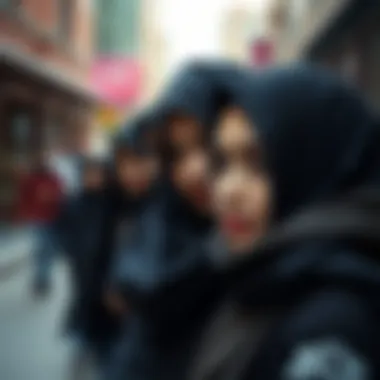
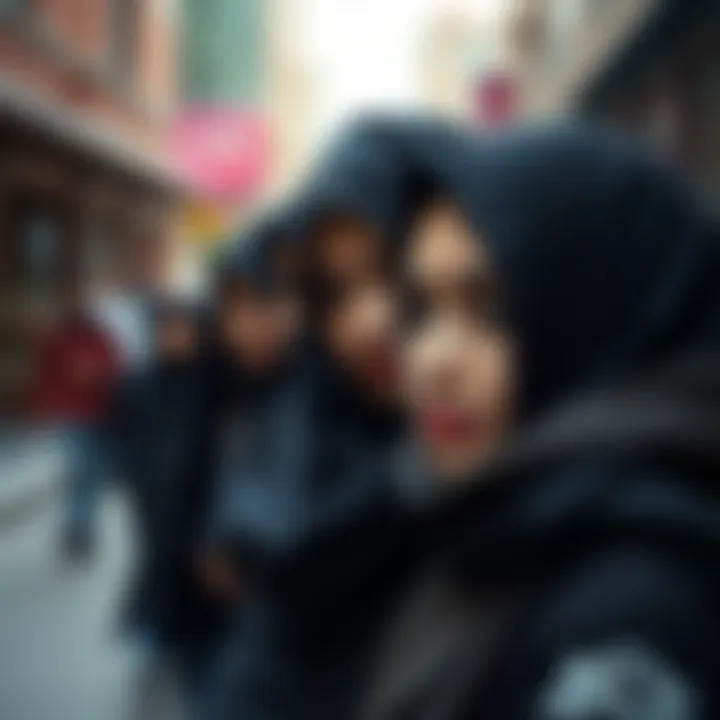
Overall, social perceptions of thick hijabs are complex yet deeply intertwined with identity, media representation, and cultural narratives. Understanding these layers can help foster a more inclusive dialogue, celebrating the diversity that thick hijabs embody.
Sustainability in Thick Hijab Production
The conversation surrounding sustainability has become paramount in various fashion sectors, and the thick hijab is no exception. As a piece that bridges modesty and style, ensuring that the production of thick hijabs is environmentally responsible adds another layer of depth to their significance. Modern consumers, especially young women, are increasingly aware of how their choices impact the planet. In this context, the importance of sustainable practices in the production of thick hijabs cannot be overstated. It involves moving beyond aesthetics and embracing ecological and ethical considerations.
Eco-Friendly Fabric Choices
When discussing eco-friendly fabric choices for thick hijabs, several materials stand out, not just for their sustainability but also for their practicality and comfort. Organic cotton, for example, is a popular choice for its breathable nature and minimal environmental impact. Unlike conventional cotton, which requires substantial water and pesticides, organic cotton is grown using methods that have a lower ecological footprint.
Another notable fabric is hemp. This material is incredibly durable and naturally resistant to mold and UV light, making it an excellent choice for those looking to marry function and fashion. Hemp requires little water and no pesticides, which aligns well with eco-conscious values.
Bamboo fabric is also gaining traction in the hijab market. Known for its softness, it has antibacterial properties and is biodegradable. Plus, its fast-growing nature makes it a renewable resource, presenting a viable option for designers aiming for sustainability.
- Natural materials: Organic cotton, hemp, bamboo
- Benefits: Breathability, durability, low environmental impact
- Trendy alternatives: Recycled fabrics, Tencel, and other sustainable textiles
Ethical Production Practices
Ethical production practices are another crucial aspect of sustainability in thick hijab production. With global awareness rising, consumers are questioning not only what they wear, but also how it’s made. Supporting brands that prioritize ethical labor practices is essential.
When manufacturers ensure fair wages and safe working conditions, they not only uplift their workers but also contribute to a more equitable fashion industry. This includes avoiding exploitative practices such as child labor and ensuring that factory conditions are humane.
Transparency is another vital component. Brands that openly share their supply chain practices foster trust and loyalty among consumers. When buyers can trace back their product to the sourcing of materials, they feel empowered in their choices.
For instance, companies that publish their sustainability reports, detailing their environmental impact and labor practices, create an avenue for conscious consumerism. These reports reflect a commitment to doing better, which is increasingly important as customers align their purchases with their values.
"Conscious fashion is not just a trend; it’s a movement towards a more sustainable and ethical world."
As the thick hijab continues to evolve within the fashion landscape, its sustainable production will play a pivotal role in shaping its future. By embracing eco-friendly materials and ethical practices, the industry can meet the demands of an informed consumer base while maintaining the cultural significance that thick hijabs represent.
The Future of Thick Hijabs
The evolution of thick hijabs reflects broader trends in fashion and culture, as well as shifts in societal attitudes towards modesty and personal expression. Understanding the future of thick hijabs involves examining the myriad of factors influencing their design, production, and portrayal within the global fashion landscape. Going beyond mere trends, these elements merge tradition with contemporary insights, allowing them to remain relevant and impactful.
Emerging Trends and Innovations
In the coming years, thick hijabs are poised to undergo a transformation that emphasizes innovation in materials and design approaches. As sustainability becomes a focal point in the fashion industry, many designers are experimenting with eco-friendly fabric options that do not compromise on quality or style.
For instance, the popularity of textiles made from bamboo fibers or recycled polyester is growing among those seeking to create a conscious fashion statement. These materials not only provide the necessary coverage but also offer breathability and comfort, making them suitable for various climates.
- Tech integration is another aspect worth noting. Designers are beginning to incorporate smart textiles that can regulate temperature or wick moisture away, thus enhancing the functionality of thick hijabs. This fusion of technology and traditional wear caters to modern women's needs, allowing them to express their identity without sacrificing comfort.
Moreover, there is a noticeable trend towards customization. As online marketplaces thrive, brands are allowing consumers the opportunity to personalize their thick hijabs, from color choices to designs or even adding embellishments. This level of involvement nurtures a deeper connection between the garment and its wearer, emphasizing individuality in a collective identity.
Influence of Global Fashion Weeks
Global fashion weeks, such as those held in Paris, Milan, and New York, play a significant role in shaping perceptions and design directions related to thick hijabs. Designers showcasing their collections on these prestigious platforms often highlight the versatility and style of hijabs in ways that challenge existing stereotypes.
The representation of thick hijabs at such high-profile events serves to demonstrate a shift in the narrative surrounding modest fashion. Rather than viewing them as mere coverings, designers are framing them as essential fashion accessories that enhance an outfit's aesthetic value.
Fashion weeks are not solely about high fashion; they create a dialogue. They allow for discussions around culture, beauty, and identity, which are increasingly being recognized and celebrated in the world of influencers and fashionistas. They continue to pave the way for carefully curated styles, encouraging people to integrate thick hijabs into various fashion narratives, pushing boundaries away from traditional expectations.
"The emergence of thick hijabs on global stages signals more than just a fashion trend; it represents a balancing act between heritage and contemporary aesthetics."
In summary, the future of thick hijabs hinges on the blend of sustainability, technological advancements, and the power of global fashion dialogues. Whether it be through smart fabrics or innovative styles showcased at fashion weeks, thick hijabs are set to strike a fine balance between tradition and modernity, ensuring their place in both fashion and cultural conversations.
The End: Thick Hijabs as a Fashion Statement
The role of thick hijabs in fashion extends far beyond mere fabric. These garments have become emblematic of a dynamic interplay between tradition and the evolving landscape of personal expression. They are not only worn for modesty but serve as bold statements of individuality and cultural identity. The importance of thick hijabs in this article lies in their multifaceted nature—spanning history, culture, and modern-day fashion trends.
Integrating Tradition with Modernity
Thick hijabs, while rooted in centuries of tradition, have successfully adapted to contemporary fashion. Styles vary widely and can reflect the cultural heritage of the wearer, even as they incorporate modern elements.
- Cultural Patterns: Many thick hijabs feature intricate designs that pay homage to various cultures while being designed with modern aesthetics in mind.
- Versatility in Fashion: These hijabs can be paired with a wide range of outfits, from casual wear to formal attire, demonstrating how tradition can evolve without losing its essence.
This blending of the old and new not only broadens the appeal of hijabs but also fosters a unique narrative that resonates with a global audience. For instance, some designers now create thick hijabs using sustainable materials—paving the way for fashion that is both conscientious and stylish.
"Fashion is not just what you wear; it's the language that you speak without words."
Encouraging Individuality
The thick hijab also plays a crucial role in promoting individual styles. For many wearers, it becomes a canvas for self-expression, allowing them to choose colors, patterns, and styles that resonate with their identity.
- Personal Customization: The trend of customizing thick hijabs is on the rise. Many individuals seek unique designs that speak to their personal journeys.
- Social Media Influence: Platforms like Instagram and Pinterest serve as spaces where wearers showcase their creative styling, inspiring others to think outside of the box and embrace their individuality.







